Desiring Histories in The Wolf Among Us
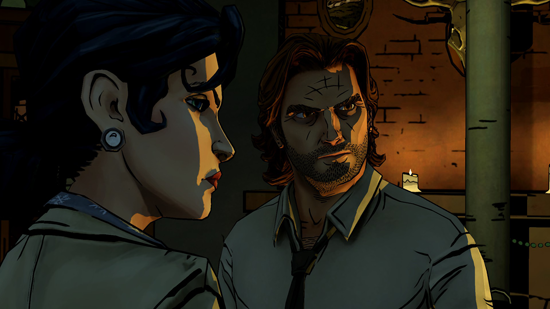 Image source: N3rdabl3.co.uk.
Image source: N3rdabl3.co.uk.
Earlier this semester, I discussed the way Once Upon a Time, particularly in its first season, played with Disney-inspired costuming to evoke nostalgia for Disney-tinged fairytales even as it valorized the present over the past. As a follow-up, and as Viz moves towards consideration of video games, I want to look at a more recent work with similar themes: the critically acclaimed fairy-tale-noir adventure game, The Wolf Among Us. In this game, the player takes on the role of a reformed Big Bad Wolf (known, now, as Bigby), who solves a series of gruesome mysteries with the help of his potential love-interest, Snow White. Specifically, I will look at three costumes associated with Snow. Like those worn by Once’s Snow White, these costumes each present a different way in which we can view the past. Unlike those in Once, these costumes trouble any clear distinction between our modern lives and the medieval-themed fairy tales that underwrite them. Instead of encouraging us to celebrate our modernity, The Wolf Among Us troubles our neat divisions between the present and the past, asking us how we use the past to think about, or act in, the present. (Content Warning: the discussion below, like the game, deals with prostitution and disturbing sexual power dynamics.)
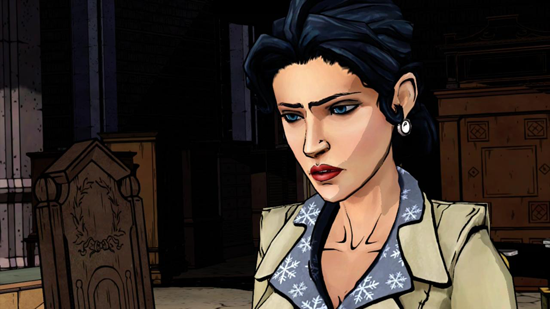 Image credit: Gamespot
Image credit: Gamespot
The first—and primary—image of Snow White in The Wolf Among Us balances carefully between the game’s two primary visual referents. Physically, she largely echoes her fairy-tale legends; perhaps more tanned than her namesake, she nonetheless wears white earrings that contrast with her “lips as red as blood” and “hair as black as ebony.” Similarly, her snowflake-decorated blouse coordinates with her blue skirt, perhaps echoing the dramatic blue coloring of the Disney Snow white’s costume, but certainly reminding viewers of her fairy-tale-princess heritage. Over that, however she wears a fitted, short blazer, its tan color and stylings evoking the trench coat of Bogart-era crime films. She thus bears on her body the generic hybrid that plays out over the course of the game’s narrative: fairy-tale characters stuck in a gritty noir universe.
The noir stylings may be incidental, but the snowflake pattern is central to the character’s self-fashioning, since they remind other Fables (fairy-tale creatures) of her high status in their world. Indeed, her relative privilege is one of the game’s central themes. While the game’s backstory posits a general amnesty that allows all New-York dwelling fairy tale characters to live harmonious lives unaffected by past crimes, those of noble birth tend to occupy the town’s upper crust. Snow herself works as the secretary for the town’s mayor, often serving as a gatekeeper determining whose concerns will and will not be heard by the government. Her authority is made more secure by a strict division between those characters whose natural form is nonhuman, and those who can naturally blend in among normal humans. The latter exclusively occupy elected positions, and often demonstrate ignorance of or hostility to the concerns of other characters. Snow’s outfit echoes her status as a recipient of considerable privilege and power, while expressing a continuity between her present position and her fairy-tale nobility.
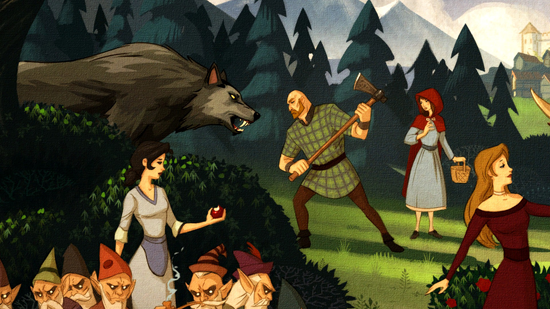 Image credit: Gizorama.com.
Image credit: Gizorama.com.
The game’s first image of the medieval Snow White places her in a far less privileged position. Her plain dress hints, perhaps, at a modest income, while her sorrowful gaze at an already-bitten reminds viewers that her original, fairy-tale self is already well-acquainted with evil. Life may have been simpler, the game argues, in the fairy-tale world, but even the pasts evoked in chilrden stories are not immune to violence and sorrow.
The apparent simplicity of the game’s medieval history is closely tied to its portrait of gender. Strikingly, Snow’s outstretched arm serves as a visual echo of the Big Bad Wolf’s snarling mouth. The contrast falls upon stereotypical lines: the Wolf’s powerful, unreflective masculine violence contrasts with Snow’s thoughtful expression. The visually powerful, angry, masculine force of the Wolf is, literally, the flip side of Snow’s contemplative femininity. The modern world, where the Big Bad Wolf wears a collared shirt and Snow is quite capable of playing hardball politics, offers a far more complex vision of gender.
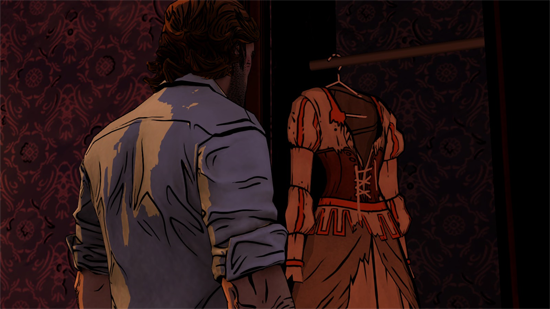 Image credit: fables.wikia.org.
Image credit: fables.wikia.org.
The final costume associated with Snow White offers the darkest interpretation of fairy-tales. In the sort of sordid twist demanded of the game’s noir atmosphere, Snow’s boss (a craven version of Ichabod Crane) has an ongoing relationship with a prostitute, a troll who wears the clothing and (thanks to magic) physical appearance of Snow herself, and who is murdered at the end of Episode 1. The clothing in question is far more complex than Snow’s medieval outfit in the earlier tapestry: its skirts, bodice, corset, and complicated sleeves hint that this is far more the product of sophisticated medieval or renaissance fashion than of an idylic childhood. Yet this dress is explicitly based on an illustrated children’s story found in the hotel where Crane staged his assignations. The third “Snow White” outfit, then, represents the present-day desire of her boss to seduce her, bizarrely re-routed through a children’s book that itself draws on medieval history.
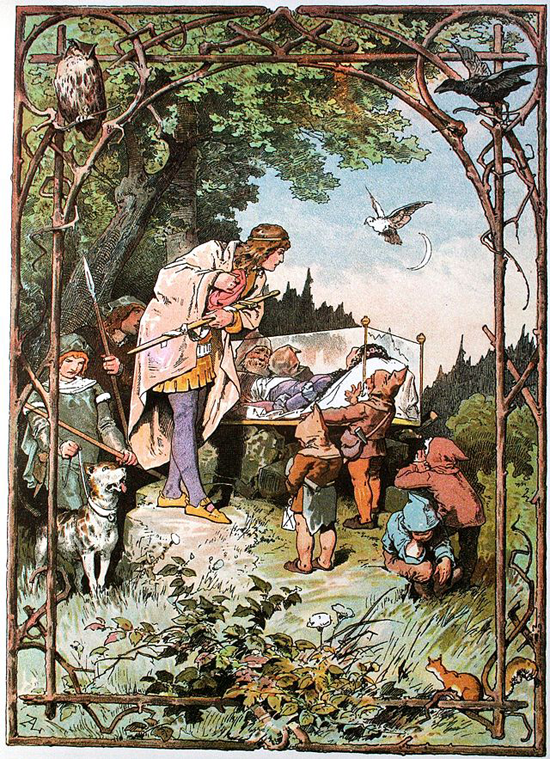 An early interpretation of Snow White by Alexander Zick (1845-1907). Image credit: Wikimedia commons.
An early interpretation of Snow White by Alexander Zick (1845-1907). Image credit: Wikimedia commons.
If the first two costumes paint a sharp contrast between a fairy-tale prehistory and a relatively muddled, gritty present, this third hints that our real-world uses of the past are similarly more complicated than we might expect. For Crane, childhood fairy-tales and medieval history are not incomplete or innocent ancestors of the present, but rather objects of desire that shape the way he imagines his employee and expresses his sexuality. Crane’s “Snow White” costume is closer to what one might expect of the princess described by the Brothers Grimm, and is very similar to the illustration inserted above, which seeks to evoke medieval aesthetics both in its costume and its mis-en-page. Yet for Crane, historical studies serve not to document the past, but to support the sordid world of his present imagination.
Of course, the game is unapologetic in its insistence that Crane is a despicable coward, and his use of children’s literature is disturbing precisely because it diverges from standard, expected uses of such works. Yet I also wonder how much Crane’s engagement with history reflects that of our own age. On the domestic, premium-cable front, Game of Thrones presents “medieval” female nudity to its audience to great financial success, reinforcing our linkage between the medieval and a male gaze pointed towards female bodies. Abroad, ISIS presents itself as a revival of medieval Islam even as it arguably deploys “profoundly modern” philosophies of statehood and violence. Perhaps the complex interweaving of modern desires and historical imagination that Crane demonstrates, then, is closer to our modern world than we might want to think.



Add new comment